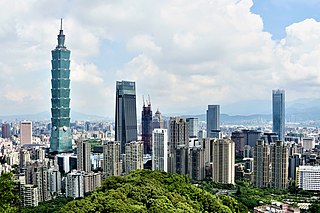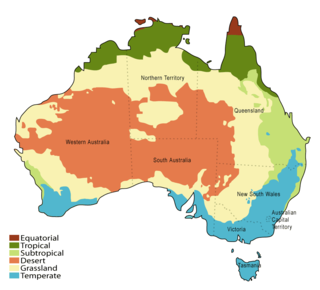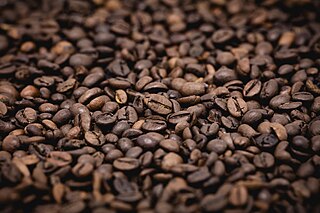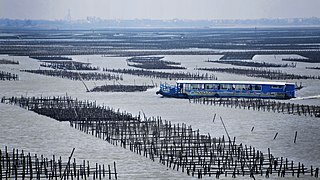




Floriculture is a significant industry in Taiwan. Taiwan is one of the largest flower exporters in the world and the top producer of orchids.





Floriculture is a significant industry in Taiwan. Taiwan is one of the largest flower exporters in the world and the top producer of orchids.
In 2011 Taiwan was one of the largest flower exporters in the world and the top producer of orchids. [1]
In 2013, Taiwan harvested flowers with a total value of NT$16.52 billion, in which US$189.7 million of it was exported. Flower plantation land spreads over an area of 138 km2. Chrysanthemum floriculture takes the most land share among other types of flowers. Taiwan is the world's largest exporter of orchids, which represented 87% of the flower export value in 2013. The main export markets for Taiwanese flowers are the United States, Japan and the Netherlands. [2]
Small scale growers receive extensive government and private support, many of these small flower growers are multi-generation family farms. [3]
Tianwei is a traditional center of the industry and is known as the “land of flowers." [4]
The high-end orchid industry began in the 1970s with amateurs and hobbyists collecting and cultivating specimens. Due to the economic expansion of Taiwan’s economy during this period these hobbyists where able to devote significant resources to developing and crossbreeding orchids. This created a dedicated local market for very expensive innovative flowers. In the 1980s major Taiwanese corporations noticed the market and began mass production with the help of Dutch companies and cultivation techniques. [3]
In the early 1990s Taiwanese flower producers played an important part in starting the modern floriculture industry in China, particularly around Kunming. [1]
In 2005 Taiwan overtook Thailand as the world’s top orchid producer. [1]
The export oriented flower market suffered during the COVID-19 pandemic with an increase in domestic consumption and government support necessary to keep the industry profitable. [5]
In 2022 Taiwan was by far the largest exporter of orchids to the United States. [6]
The Taipei Flower Market is the largest plant and flower market in Taiwan. [5]
The Taiwan Floriculture Development Association is the primary industry association. [5] Associations also exist for high value sub-groups such as orchid producers. [1]

The economy of Taiwan is a highly developed free-market economy. It is the 8th largest in Asia and 20th-largest in the world by purchasing power parity, allowing Taiwan to be included in the advanced economies group by the International Monetary Fund. Taiwan is notable for its rapid economic development from an agriculture-based society to an industrialised, high-income country. This economic growth has been described as the Taiwan Miracle. It is gauged in the high-income economies group by the World Bank. Taiwan is one of the most technologically advanced computer microchip and high-tech electronics industries makers in the world.

Table grapes are grapes intended for consumption while fresh, as opposed to grapes grown for wine production, juice production, or for drying into raisins.

The arms industry, also known as the defense industry, military industry, or the arms trade, is a global industry which manufactures and sells weapons and military technology. Public sector and private sector firms conduct research and development, engineering, production, and servicing of military material, equipment, and facilities. Customers are the armed forces of states, and civilians. An arsenal is a place where arms and ammunition – whether privately or publicly owned – are made, maintained and repaired, stored, or issued, in any combination. Products of the arms industry include weapons, munitions, weapons platforms, military communications and other electronics, and more. The arms industry also provides other logistical and operational support.

Floriculture is the study of the efficient production of the plants that produce showy, colorful flowers and foliage for human enjoyment and the human environment. It is a commercially successful branch of horticulture and agriculture found throughout the world. Efficient production practices have been developed over the years, for the hundreds of plant taxa used in the floral industry, increasing the overall knowledge of whole plant biology. Plant breeding and selection have produced tens of thousands of new genotypes for human use. Jasmine, Marigold, Chrysanthemum, Rose, Orchid, Anthurium, etc. are flowers of commercial demand.

Although Australia is mostly arid, the nation is a major agricultural producer and exporter, with over 325,300 people employed in agriculture, forestry and fishing as of February 2015. Agriculture and its closely related sectors earn $155 billion a year for a 12% share of GDP. Farmers and grazers own 135,997 farms, covering 61% of Australia's landmass. Across the country, there is a mix of irrigation and dry-land farming. The success of Australia in becoming a major agricultural power despite the odds is facilitated by its policies of long-term visions and promotion of agricultural reforms that greatly increased the country's agricultural industry.

Canadian wine is wine produced in Canada. Ontario and British Columbia are the two largest wine-producing provinces in Canada, with two-thirds of the Canada's vineyard acreage situated in Ontario. However, wine producing regions are also present in other provinces, including Alberta, Quebec, New Brunswick and Nova Scotia.

Coffee is a popular beverage and an important commodity. Tens of millions of small producers in developing countries make their living growing coffee. Over 2.25 billion cups of coffee are consumed in the world daily. Over 90 percent of coffee production takes place in developing countries — mainly South America — while consumption happens primarily in industrialized economies. There are 25 million small producers who rely on coffee for a living worldwide. In Brazil, where almost a third of the world's coffee is produced, over five million people are employed in the cultivation and harvesting of over three billion coffee plants; it is a more labor-intensive culture than alternative cultures of the same regions, such as sugar cane or cattle, as its cultivation is not automated, requiring frequent human attention.

The floral industry is focused on the production, distribution and sale of flowers for human enjoyment. The floral industry began in the Golden Century of the Netherlands, where flowers were grown on a large scale on vast estates. The industry continues to diversify from the production of cut flowers to the production and sale of plants and flowers in many different forms. The global floral industry market size is estimated to be worth US$ 50040 million in 2022 and is forecast to increase to US$ 58030 million by 2028 with a compound annual growth rate of 2.5% during the review period.

Agriculture in Colombia refers to all agricultural activities, essential to food, feed, and fiber production, including all techniques for raising and processing livestock within the Republic of Colombia. Plant cultivation and livestock production have continuously abandoned subsistence agricultural practices in favour of technological farming resulting in cash crops which contribute to the economy of Colombia. The Colombian agricultural production has significant gaps in domestic and/or international human and animal sustenance needs.
Villa Guerrero is a municipality in the State of Mexico, Mexico. The municipal seat is the town of Villa Guerrero. It is located on the southern slopes of the Nevado de Toluca, also known as Xinantecatl, and is 50 minutes/58 km from Toluca.

Agriculture is one of the main industries in Taiwan. It contributes to the food security, rural development and conservation of Taiwan. Around 24% of Taiwan's land is used for farming.
The Kenya Flower Council is a voluntary body of industrial association for floriculture in Kenya. Its secretariat is in Nairobi.

Agriculture in Malaysia makes up twelve percent of the nation's GDP. Sixteen percent of the population of Malaysia is employed through some sort of agriculture. Large-scale plantations were established by the British. These plantations opened opportunity for new crops such as rubber (1876), palm oil (1917), and cocoa (1950). A number of crops are grown for domestic purpose such as bananas, coconuts, durian, pineapples, rice and rambutan.

Cut flowers are flowers and flower buds that have been cut from the plant bearing it. It is removed from the plant for decorative use. Cut greens are leaves with or without stems added to the cut flowers for contrast and design purposes. These displays improve the quality of the human environment.

The International Association of Horticultural Producers is a trade association dedicated to promoting horticultural producers and held the international garden / flora festivals or expositions.

The Agriculture Department is a department of the Government of Punjab, Pakistan. It is responsible for legislation, policy formulation, and development of agriculture sector in Punjab.

The maritime industries of Taiwan are a large part of Taiwan's economy. Industries of particular importance are shipbuilding, boat building, maritime transport, aquaculture, mariculture, commercial fishing, seafood processing, offshore wind power and various forms of tourism. Deep sea mining, especially of dormant hydrothermal vents, is also being considered for the future. In 2018 Taiwan was the fourth largest yacht building nation. Taiwan is home to a number of maritime museums and maritime colleges.

Banana production in Tawain is an essential aspect of the agriculture of Taiwan. Japanese consumers commonly purchase bananas grown in Taiwan.

Pineapple is one of the fruit crops produced in Taiwan.

Aquaculture has a long history in Taiwan and is an important component of the Maritime industries of Taiwan.